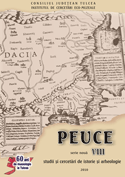Ceramică fină descoperită la Aegyssus
Fine pottery from Aegyssus
Author(s): Georgică Costea, George NuţuSubject(s): Archaeology
Published by: Institutul de Cercetari Eco-Muzeale Tulcea - Institutul de Istorie si Arheologie
Keywords: Early Roman Period; Moesia Inferior; Northern Dobrudja; Aegyssus; Roman Fine Pottery; epocă romană timpurie; Moesia Inferior; nordul Dobrogei; Aegyssus; ceramică romană fină
Summary/Abstract: In the year 2007 a rescue excavation took place at Aegyssus, on 62, Gloriei Street. On this occasion three archaeological levels (one Medieval and two Roman) were discovered. The Roman finds consist of a large quantity of pottery, dated from the 1st century to the 3rd century A.D. The pottery forms are common to this period: amphorae, fine pottery (bowls, dishes, cups, jugs) and lamps. Additionally, some Late Roman pottery, including some fragments of Kuzamnov 16 type, was discovered. The authors choose to present, in a first article dedicated to this archaeological research, the Roman fine pottery because this variety is almost unknown in the Aegyssus area. From the production areas point of view, the fine pottery from Aegyssus can be divided in four main categories: the Pontic types including Pontic sigillata and Red Slip, the Çandarli Wares, Hayes Form 1 and Form 3, the African Red Slip and the Western Sigillata. We hope that the presentation of these forms will contribute to a better understanding of pottery production and circulation and of the economic exchanges at the Danube’s Mouths in the first three centuries of the Christian era.
Journal: Peuce (Serie Nouă) - Studii şi cercetari de istorie şi arheologie
- Issue Year: VIII/2010
- Issue No: 8
- Page Range: 147-162
- Page Count: 16
- Language: Romanian

